Ekranoplan is a Russian word formed as joining of "ekran", corresponding to
the screen, and "plan", corresponding to the plane. In sixties of 20th century, when Rostislav Alexiev
designed a craft flying very close to the sea surface, the Russians called this airplane-ship
mixture vehicle as "ekranoplan".
While Russian engineers working on their ekranoplan, engineers from some other
countries were looking for a way of using the advantage of the ground effect in all phases of
flight. Independent studies started to give their fruits by seventies and many
flying ground effect vehicles desinged and manufactured. Different names
were given to this craft by different nations, but the more general one is WIG as the
abraviation of Wing In Ground effect. Today, there is a market for the WIGs
of Russia, Germany, Japan, Australia, USA, China, France and Corea.
What is a WIG Craft?
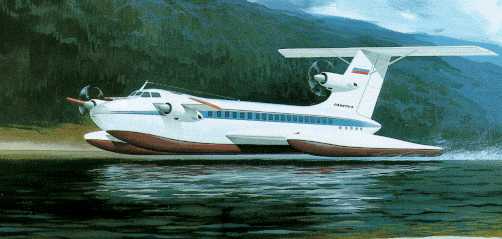
A WIG can be defined as a marine craft cruising just above
the water surface with an achievable speed in excess of 60 knots.
Conventional marine craft capable of reaching those speeds have excessive fuel
consumption. However, a WIG reduces its drag to a minimum by eliminating
hydrodynamic drag some like a hovercraft. In hovercraft technology, an
air cushion is created synthetically between the craft and the water to reduce the hydrodynamic
drag. There is no need for such a cushion in WIG technology since it is created by aerodynamics.
This means that when the WIG craft has sufficient forward speed a dynamic aircushion exists
as opposed to the hovercrafts static air cushion.

A WIG can also be defined as an aircraft that flies in ground effect not in landing and takeoff
but in all phases of flight. But one should be very careful with this definition. Because a
WIG is not simply an aircraft. Except some few samples, most WIGs can not fly without ground
effect. Usually their cruising height is limited with the chord of the wing since above this,
the ground is not effected anymore. There is no need for runways to operate WIGs due to the
fact that they take-off and land on the sea surface.
What is Ground Effect?
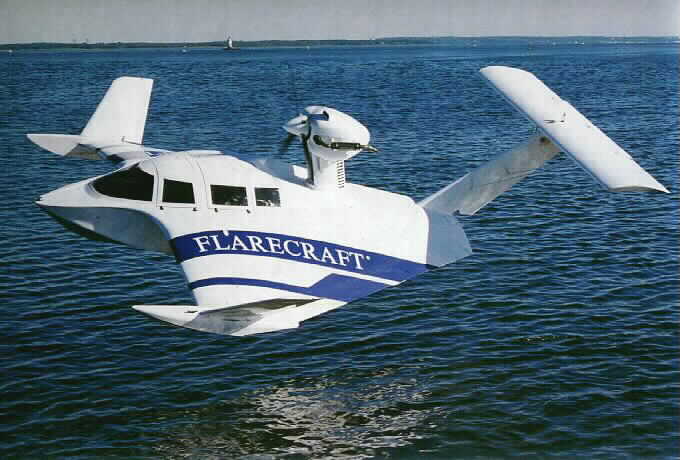
Ground effect is a natural phenomena that occurs when a lifting body moves close enough to a
screen. A conventional wing flying at an altitude smaller than its chord will have a higher
lift to drag ratio than that of the same wing flying far above this altitude. Because, the
existance of ground modifies the fluid flow such that the induced drag of the wing reduces up
to a 30 percent and the lift of it increases fairly, to give a total of increase in lift to
drag ratio. This ratio, generally speeking, represents the efficiency of the aircraft.
A higher lift to drag ratio means a more weight that can be transported with a definite fuel
consumption.
Problems in WIG Technology
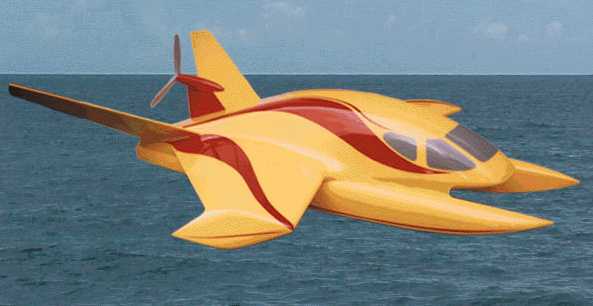
The most important problem is the fulfilment of the requirement to the high amount of longitudinal
stability. Longitudinal stability is significantly important in WIG technology because the
operational height of the vehicle is small. There are lots of quite bad experiences with WIGs
due to the unstability; accidents like a boat turning over. To be able to operate WIGs on a
wavy water and during all seasons, some inherrient stability should they posses.
The another problem is getting out of water, the required power for take-off is a number of
times higher than that required for cruising. This is due to the high drag in the water just before
leaving the water surface.
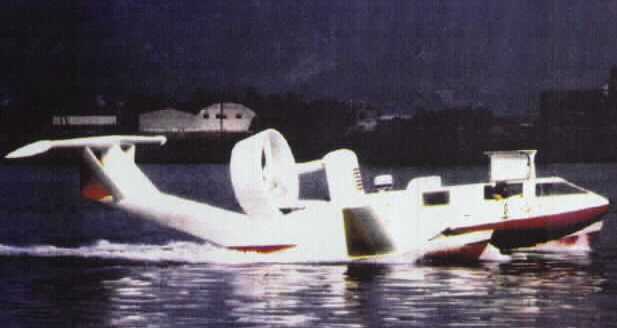
The structural units of WIGs should be choosen by considering that they
are used as parts of a vehicle that operates very close to the water. The
water is a problem especially for the engine of the WIG craft.
Obstacles that possibly be encountered at a flight of such a low altitude should also be
considered as a problem for WIG manufacturers.
Position of WIGs in Transport Vehicles
Reference :
"The WIG Page"
Graphing is a good way to see the position of WIGs in all other transport vehicles of different
types and sizes. Von Karman-Gabrielli diagram is shown. In this diagram the L/D is given as a
function of the speed.
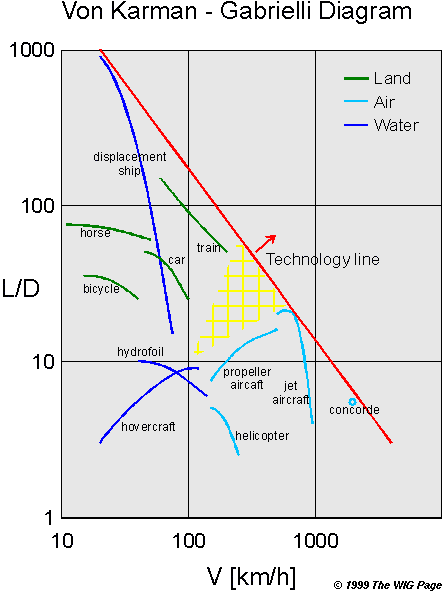
A very remarkable feature in the Von Karman-Gabrieli diagram is the red line, all current forms
of transport are below that line. This line is called the technology line, it is pushed towards
the upper right corner with advancing technology.
In the diagram, there is a niche represented by the yellow triangle. This
is just the area where a WIG would be located, with a cruise speed of 100
to 400 km/h and a L/D of 15 to 30. But, is there really a need for such a
vehicle?
Someone may think that a turboprop aircraft can fill this cavity and there
is no need to consider WIGs. However, engineers will compare
the advantages and disadvantages of the candidates to use in that area.
WIGs are cheaper in manufacturing and in operation; as mentioned
before they are free in need to runways. On the other hand, they are
limited in operation in costal areas and large wakes, especially for small
WIGs. Today, the need for such a vehicle depends on purpose but for
the future, they give hope worthwhile to be dealt with.
Comparing the efficiencies of different transport vehicles may be achived by drawing their
power to weight ratio versus velocity diagram as given below.
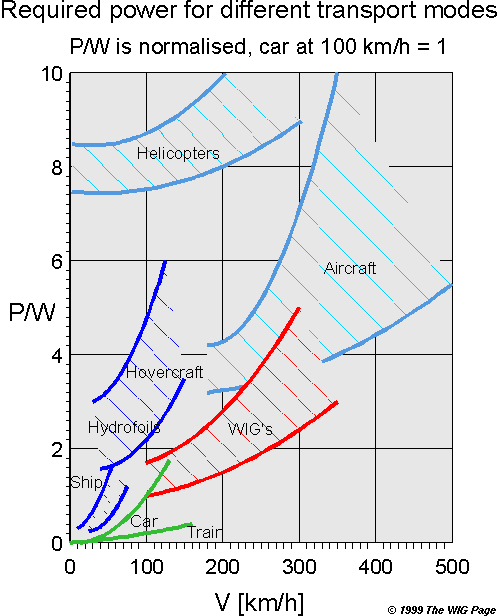
The creation of WIGs lies behind the demand for fast and economical transportation of both passenger
and cargo. To get the full efficiency, the size of WIGs should be extremely large, at hundered of
tons. However, manufacturing such a big craft without an advanced ground effect technology and
without knowing the demand in the market for it would not be a wise way. Therefore,
the engineers working on WIGs started with smaller designs to prove the technology. These small
WIGs have exposed the problems of WIGs in long term usage, initiated the certification rules and
built up the operational experience.
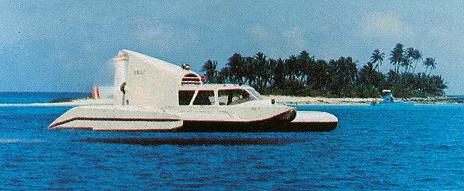
First generation 2-10 ton small WIGs are used not over oceans but in lakes as sea taxis. Their
capacity varies from one to 20 passenger or equivalent of load. They can operate in waves from
0.25 to 1 metre in height.
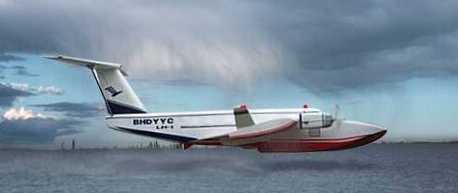
By the help of some experience gained with operation of these small WIGs,
somewhat larger WIGs are developed to provide scheduled passenger
and freight services. They have better seaworthiness allowing them to operate almost all year
around to overcome the waves up to 2-3 meters. The craft can accomodate 20 to 200 passengers and
they may weigh up to 100 tons.
In the near future, WIGs of hundered of tons may take the place of ships in transportation of
bulk goods over oceans. They can offer a cheaper, faster and safetier flight.
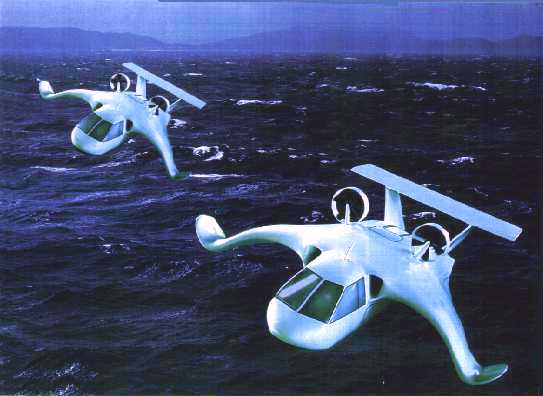
(To discuss on the subject
write to me
.)
Gülkız Doğan